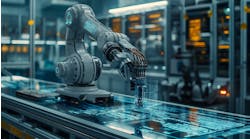Manufacturing in 2020: Connecting Machines to Networks and Companies to End-Consumers
While change is buffeting the industrial manufacturing industry from a number of directions, the most disruptive changes will be those which manufacturers can and should make for themselves. Many manufacturers already are taking advantage of technologies like the Internet of Things (IoT), and as we head into 2020 will find themselves early adopters of things like Artificial Intelligence, 5G, and 3D printing.
In a departure from past manufacturing technology adoption cycles, the focus will not be entirely on incremental improvement of existing processes. These technologies will find their way to the core of new and innovative business models and revenue streams that will change the very nature of industrial manufacturing.
1. 5G will have more machine customers than human customers. By the end of 2020 there will be more manufacturing devices connected by 5G than there will be people on 5G networks.
Bernard Marr in Forbes points out the tremendous impact 5G will have when it comes to enabling other technologies. Streaming music, TV shows, and movies in an uninterrupted way via mobile devices will indeed be easier and more affordable with 5G. But 5G will be more transformational for devices that drive automated industrial processes than for consumer-facing smart devices.
“These advancements will enable connected cars and autonomous driving,” Marr writes. “Smart cities with connected logistics, transport, and infrastructure; enhancement in connected healthcare from robotics to blockchain use cases, to wearable telemetry; Industrial Internet of Things and Smart factories; and the more extended use of augmented reality, virtual reality, and mixed reality.”
I predict that 5G will make its greatest impact in industrial automation. The ultra-low-latency, ubiquitous connectivity will power sensors on industrial machines, enabling them to talk to each other and generate floods of data that, through machine learning, will unlock new vistas of cost savings and efficiency. China and South Korea are already working in this way and the U.S. and the U.K. are likely to spend much of the coming year ensuring they don’t get left behind.
Improved communications between machines due to 5G will lead not just to increased efficiency, but rather to the ability to automate more complex manufacturing models, including configure-to-order and make-to-order. Levels of automation formerly associated only with long-run, repetitive manufacturing then will be able, thanks to the high speed of 5G, to automate multivariate production runs that may result in custom products, regional mass customization, or highly configured products, all with less human involvement than currently is the case.
2. The B-2-B-2-C model will start to compete in earnest with the B-2-C model. The movement of manufacturers from their traditional perch at the far end of the value chain toward the consumer is underpinned by the global trend of "servitization" —product-oriented companies either adding services to their products or selling their products as services on a subscription basis.
IFS data suggests that as early as 2018 62% of manufacturers were already benefiting from aftermarket revenue— through parts, warranty .or proactive service contracting. A full 16% of respondents were offering maintenance contracts with specific service-level agreements (SLAs), but only 4% of manufacturers offered products entirely as a service — i.e., full servitization.
What this means is that even if a manufacturer is selling its product through a channel of distribution, it may be supporting or servicing that product directly over its lifecycle.
Suddenly, the manufacturer is a business-to-business-to-consumer company. It now has a service relationship that will drive much of its revenue, and it may be responsible for delivering an outcome rather than just the product.
As an example, one of our customers is an air filter manufacturer that produces and sells filtration systems, historically through a standard business-to-business model. But through servitization, it has made the transition from selling air cleaners to selling clean air. It works proactively with customers to measure their existing "air quality", establish an air-quality goal and then maintain the filtration system to deliver that outcome. Much of this process is automated, as sensors in the equipment monitor results and can dispatch technicians, order parts, and execute on a condition-based maintenance program.
For this business, however, preventative maintenance is only the beginning. As big data manipulation and analytics becomes easier, the opportunity to garner more information about what is happening to the air quality in particular environments will increase exponentially.
Customer experience will improve as the business-to-business-to-consumer model takes hold because there will be more direct communication between the manufacturer and the end consumer of a product. This model also will benefit the environment as the number of items being built and resources going into them matches the requirements for a task rather than the whims of a consumer.
3. Over half of manufacturers will have invested in AI technology, and improved productivity by over 10%. IFS has been working with clients to combine machine-learning applications with multiple large data sets and using them to identify patterns and strategies that are beyond what the human mind can conceive.
Most manufacturers already employ some level of automation—not just on the plant floor but in the front office. Dried fruit and snack manufacturer Whitworths is a good example. It has reached a high degree of automation in quality management, moving from period random testing of product and manual recording to a streamlined process driven directly by the shop order. While automation streamlines processes, AI will be able to create net new processes. So a company like Whitworth may be able to predict quality problems before they happen, or create new AI-driven flavors to meet an individual customers’ tastes, as did distiller Diageo.Another area that will continue to develop over the coming years is AI-powered demand planning and forecasting. As AIs are trained on the right data sets, manufacturers will be able to align their supply chain with demand projections to get insights that were previously unimaginable.
This in turn brings about a new mindset of the manufacturer, who is likely to only consider the manufacturing process as beginning in the factory and finishing when the goods leave the warehouse. Just-in-time, the Toyota Production System concept, will be taken to new heights, in large part because AI allows a manufacturer to ask, “in time for what, exactly?”. What is the event or combination of events that should trigger replenishment—a demand signal, a price drop in the component part or raw material—it could be anything, and the relationship may not be apparent without AI.
In a November 2019 study from IFS, 40% of manufacturers said they were planning to implement AI for inventory planning and logistics, followed by production scheduling and customer relationship management, each at 36%. A majority of 60% of total respondents said they were targeting productivity improvements with these investments.
2020 really should be an exciting year. After decades of incremental productivity growth, the result of lean initiatives, automation and stern discipline, manufacturers will use technology not to optimize, but to create. AI will let us create new ways of doing things, and that means new revenue.
Antony Bourne is senior vice president for IFS Industries, a developer of enterprise software for manufacturers and distributors. He has over 20 years of experience in IT, including in manufacturing, and he held business analyst positions with Ford Motor Co. and AlliedSignal. Contact him at LinkedIn, or visit www.IFS.com/us.






